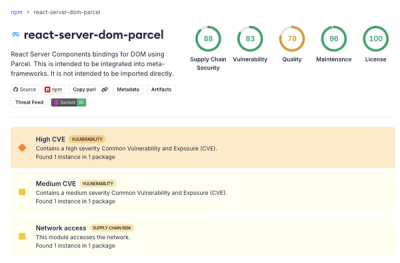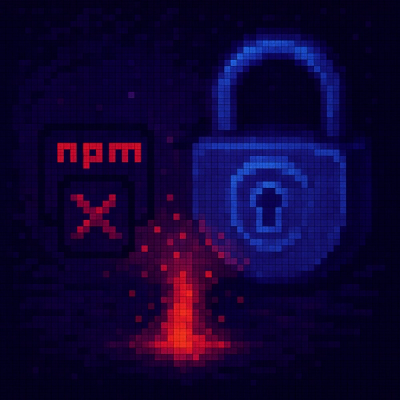
Security News
New React Server Components Vulnerabilities: DoS and Source Code Exposure
New DoS and source code exposure bugs in React Server Components and Next.js: what’s affected and how to update safely.
jsdoc-http-plugin
Advanced tools
This project is a fork of https://github.com/bvanderlaan/jsdoc-route-plugin Currently, bvanderlaan doesn't seems to be available to maintain the project so i'll continue here.
This is a plugin for JsDoc which is a tool to generate HTML documentation from comment blocks. JsDoc will scan your code files looking for comment blocks then generate a nicely formated HTML document.
JsDoc supports a number of tags to help document a number of things such as each parameter in a function or what the function will return. These tags are picked up by JsDoc and used when generating the HTML documentation; for example function parameters are shown in a table.
This plugin adds custom tags to JsDoc that work with the default document template. The custom tags are meant to help document HTTP endpoints.
First you need to install JsDoc
npm install jsdoc --save-dev
Then you need to install the JsDoc Route Plugin
npm install jsdoc-http-plugin --save-dev
Next you need to tell JsDoc to enable the plugin.
You can do this by adding a jsdoc.conf file and telling JsDoc to use it when you run it.
Example jsdoc.conf
{
"tags": {
"allowUnknownTags": true,
"dictionaries": ["jsdoc","closure"]
},
"source": {
"include": [ "." ],
"exclude": [ "node_modules" ],
"includePattern": ".+\\.js(doc|x)?$",
"excludePattern": "(^|\\/|\\\\)_"
},
"plugins": ["jsdoc-http-plugin"],
"templates": {
"cleverLinks": false,
"monospaceLinks": false
},
"opts": {
"recurse": true
}
}
Now run JsDoc with the --config flag.
jsdoc --config jsdoc.conf
when used with markdown plugin, it should be put before jsdoc-http-plugin
"plugins": ["plugins/markdown", "jsdoc-http-plugin"],
If you want to see an example of this plugin in action run the npm run example1 command.
That will run JsDoc against a sample Express app located in examples and produce HTML documentation in the out folder.
To view the documentation open out/index.html in a browser.
The new tags are all about documenting Express routes. Find a list of them and how they are to be used below.
Because JsDoc does not know about routes we need to decorate the route documentation with the @name tag to make JsDoc think you are documenting a member of the given module.
This will add an entry under the Members section in the HTML document; however, if we used only the @name tag to describe the route verb and path it might look a bit odd as it would show up like this:
(inner) POST /v1/files
To make documenting a route a bit nicer I suggest using the @name tag to define a common name for the route, such as File Upload, and the @path tag to define the verb and route path.
Using the @path tag will also change the method attribute from (inner) to (path).
/**
* Upload a file.
*
* @name File Upload
* @path {POST} /v1/file
*/
server.post({
url: '/v1/file',
}, (req, res, next) => {...}
The @path tag will add a table showing the HTTP verb (i.e. POST, PUT, DEL, GET), and the route path (i.e. /v1/files) for the route you are documenting just under the friendly name of the route above the details section.
Only one @path tag is expected per endpoint document.
The @auth tag allows you to state what authentication a route requires.
/**
* Upload a file.
*
* @name File Upload
* @path {POST} /v1/file
* @auth This route requires HTTP Basic Authentication. If authentication fails it will return a 401 error.
*/
server.post({
url: '/v1/file',
}, (req, res, next) => {...}
It will result in a new sub-heading called Authentication with whatever text you provided to the tag beneath it.
Only one @auth tag is expected per endpoint document.
The @header allows you to document any parameters which are passed via the header of the HTTP request.
With this tag you need to provide the name and a description. The name is the first word of the text following the tag.
@header MyName And this part is the descriptionYou can also optionally provide a type for the parameter.
@header {String} MyName And this part is the description/**
* Upload a file.
*
* @name File Upload
* @path {POST} /v1/file
* @header authorization is the identification information for the request
* @header {String} user-id is the unique User Id to assign to the file
*/
server.post({
url: '/v1/file',
}, (req, res, next) => {...}
The above would add a table under the route description that lists all the header parameters.
You can use the @header tag as many times as you have parameters in your request header you wish to document.
The @body allows you to document any parameters which are passed via the body of the HTTP request.
With this tag you need to provide the name and a description. The name is the first word of the text following the tag.
@body MyName And this part is the descriptionYou can also optionally provide a type for the parameter.
@body {String} MyName And this part is the descriptionYou can also specify that the parameter is optional by placing the name within square brackets.
@body {String} [MyName] And this part is the descriptionLastly you can define a default value for the parameter. The idea is to document the value which will be used if the parameter is not provided.
@body {String} [MyName=Phillip] And this part is the description/**
* Upload a file.
*
* @name File Upload
* @path {POST} /v1/file
* @body {String} userId is the unique identifier for the user we are uploading the file to.
* @body {Boolean} [sync=false] when true the route will be synchronous otherwise the route
* is asynchronous.
*/
server.post({
url: '/v1/file',
}, (req, res, next) => {...}
The above would add a table under the route description that lists all the body parameters.
You can use the @bodyparam tag as many times as you have parameters in your request body you wish to document.
The @params allows you to document any parameters which make up part of the route path.
With this tag you need to provide the name and a description. The name is the first word of the text following the tag.
@params MyName And this part is the descriptionYou can also optionally provide a type for the parameter.
@params {String} MyName And this part is the description/**
* Download a file.
*
* @name Download File
* @path {GET} /v1/files/:fileId
* @params {String} :fileId is the unique identifier for the file to download.
*/
server.get({
url: '/v1/files/:fileId',
}, (req, res, next) => {...}
The above would add a table under the route description that lists all the route parameters.
You can use the @params tag as many times as you have parameters in your route path.
The @query allows you to document any parameters which are passed via HTTP request url.
With this tag you need to provide the name and a description. The name is the first word of the text following the tag.
@query MyName And this part is the descriptionYou can also optionally provide a type for the parameter.
@query {String} MyName And this part is the descriptionYou can also specify that the parameter is optional by placing the name within square brackets.
@query {String} [MyName] And this part is the descriptionLastly you can define a default value for the parameter. The idea is to document the value which will be used if the parameter is not provided.
@query {String} [MyName=Phillip] And this part is the description/**
* Download files.
*
* @name Download Files
* @path {GET} /v1/files
* @query {String} [fileType] will limit the download to just these file types.
*/
server.get({
url: '/v1/files',
}, (req, res, next) => {...}
The above would add a table under the route description that lists all the query parameters.
You can use the @query tag as many times as you have parameters in your request url you wish to document.
The @response allows you to document the response that your route will make
With this tag you need to provide the name and a description. The name is the first word of the text following the tag.
@response MyName And this part is the descriptionYou can also optionally provide a type for the parameter.
@response {String} MyName And this part is the descriptionYou can also specify that the response is optional by placing the name within square brackets.
@response {String} [MyName] And this part is the descriptionLastly you can define a default value for the parameter.
@response {String} [MyName=Phillip] And this part is the description/**
* Download files.
*
* @name Download Files
* @path {GET} /v1/files
* @response {Object} metadata
* @response {String} metadata.name
* @response {String} metadata.link
*/
server.get({
url: '/v1/files',
}, (req, res, next) => {...}
The above would add a table under the route description that lists that the route answer with a json document containing the name and link key.
You can use the @response tag as many times as you have parameters in your response you wish to document.
The @code allows you to document the http response code that your route will make
With this tag you need to provide the number like this
@code {200} and then you document why this code is happening/**
* Download files.
*
* @name Download Files
* @path {GET} /v1/files
* @code {200} if the request is successful
* @code {500} if the request fail because the database isn't accesible
* @response {Object} metadata
* @response {String} metadata.name
* @response {String} metadata.link
*/
server.get({
url: '/v1/files',
}, (req, res, next) => {...}
The above would add a table under the route description that lists that the route answer with a json document containing the name and link key.
You can use the @response tag as many times as you have parameters in your response you wish to document.
The @service allows you to document the host used to make a the request, in the time of microservice, you may have to hit a specific host to reach a specific microservice, you may say that they must be behind a load balancer, but in localhost thats not always the case.
With this tag you need to provide the number like this
@service API/**
* Download files.
*
* @name Download Files
* @service DOWNLOAD
* @path {GET} /v1/files
* @code {200} if the request is successful
* @code {500} if the request fail because the database isn't accesible
* @response {Object} metadata
* @response {String} metadata.name
* @response {String} metadata.link
*/
server.get({
url: '/v1/files',
}, (req, res, next) => {...}
The @chain allows you to document the sequence of handlers which will handle the request before current endpoint or middleware, for e.g it may be the express.js middlewares.
With this tag you may provide @link or human-friendly name of chain element. It is important to keep order of @chain declarations same as real request handling order.
@chain {@link module:<full-path-to-module-member>} || @chain <human-friendly-endpoint-name>/**
* Handlers chain - example middleware
*
* @name SomeMiddleware
* @path {POST} /v1/chain
* @version v1
* @since v1
*/
app.get('/v1/chain', function (request, response, next) {
...
next()
})
/**
* Handlers chain - endpoint after the middleware
*
* @name SomeEndpoint
* @path {POST} /v1/chain
* @version v1
* @since v1
* @code 200
* @chain {@link module:MyRoutes.SomeMiddleware}
* @chain This handler
*/
app.get('/v1/chain', function (request, response) {
...
})
The above would add a table under the route description that lists that the route answer with a json document containing the name and link key.
Bug reports and pull requests are welcome on GitHub at https://github.com/vmarchaud/jsdoc-http-plugin. This project is intended to be a safe, welcoming space for collaboration, and contributors are expected to adhere to the Contributor Covenant code of conduct.
The library is available as open source under the terms of the MIT License.
FAQs
Plugin to add HTTP Route tags for documenting HTTP endpoints
We found that jsdoc-http-plugin demonstrated a not healthy version release cadence and project activity because the last version was released a year ago. It has 1 open source maintainer collaborating on the project.
Did you know?

Socket for GitHub automatically highlights issues in each pull request and monitors the health of all your open source dependencies. Discover the contents of your packages and block harmful activity before you install or update your dependencies.

Security News
New DoS and source code exposure bugs in React Server Components and Next.js: what’s affected and how to update safely.

Security News
Socket CEO Feross Aboukhadijeh joins Software Engineering Daily to discuss modern software supply chain attacks and rising AI-driven security risks.

Security News
GitHub has revoked npm classic tokens for publishing; maintainers must migrate, but OpenJS warns OIDC trusted publishing still has risky gaps for critical projects.